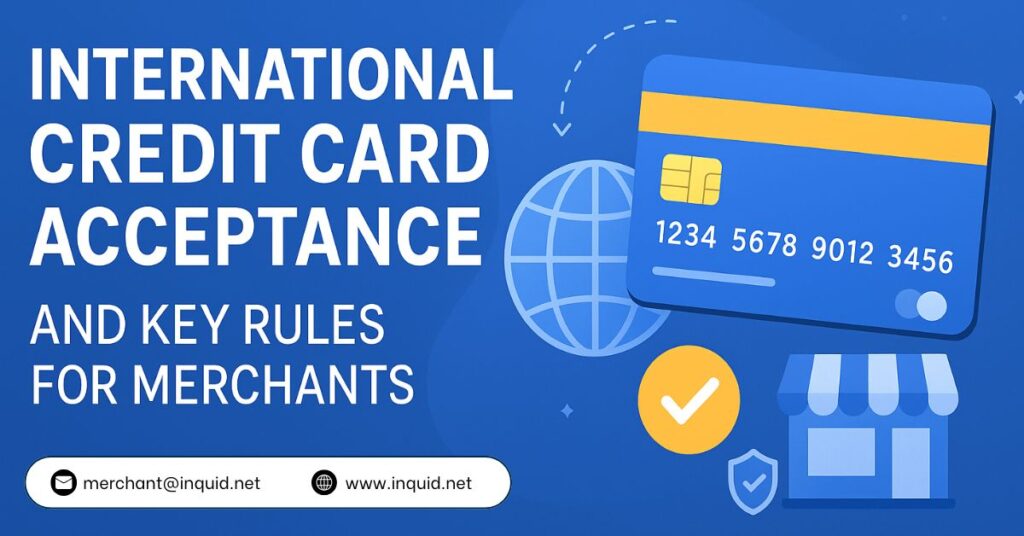
Accepting international credit card acceptance opens doors to customers across the globe. However, it also brings a set of requirements and best practices that merchants must follow to avoid delays, chargebacks, or unexpected losses. From choosing the right gateway to understanding compliance rules, success depends on getting the details right from the start.
Why International Credit Card Acceptance Matters
When customers can pay in their preferred currency and method, they are far more likely to complete a purchase. Offering multiple card options also helps merchants tap into new markets without the need for complex local setups. A well-chosen international payment gateway can process transactions quickly while meeting regional regulations.
For merchants operating in high-volume or high-risk industries, accepting cards from different countries can make the difference between a limited customer base and a truly global reach. But it’s not as simple as flipping a switch—there are rules and operational adjustments to consider.
Key Rules Every Merchant Should Know
1. Comply with PCI DSS Standards
PCI DSS (Payment Card Industry Data Security Standard) compliance is mandatory for any business handling credit card data. It involves securing customer information during and after transactions. Non-compliance can result in heavy fines, loss of processing privileges, and damage to brand trust. Merchants should work with providers that are already PCI-compliant to reduce their security burden.
2. Be Transparent with Currency and Fees
Unexpected currency conversion costs or hidden fees can lead to disputes. Always display the transaction currency clearly at checkout and inform customers about any additional charges. Some credit card processing platforms allow for multi-currency pricing, making it easier for customers to see the exact amount they will be charged.
3. Understand Local Regulations
Each country has its own rules for card transactions. Some regions require additional verification steps like 3D Secure, while others have restrictions on certain industries. Ignoring these laws can result in failed payments or account freezes. Partnering with a provider experienced in cross-border transactions helps avoid these roadblocks.
4. Optimize for Card Approval Rates
International transactions sometimes face higher decline rates due to fraud prevention systems. To improve approval rates, ensure your payment gateway can route transactions through local acquiring banks when possible. Using tools that identify legitimate customers and flag suspicious activity can reduce false declines. Merchants can also work with providers that help accept credit card payments globally without unnecessary rejections.
5. Prepare for Chargeback Disputes
Chargebacks are more common in international sales because of currency issues, delayed shipments, or unclear policies. Keep detailed transaction records, shipment tracking, and clear refund policies to handle disputes efficiently. Some payment processors offer built-in chargeback management tools that can save time and money.
Choosing the Right Gateway for International Sales
Selecting the right gateway is not just about processing speed—it’s about compatibility with your target markets, currencies, and compliance requirements. A reliable provider should support multiple card brands, local payment options, and offer fraud protection without adding friction for customers.
Merchants looking to expand abroad should focus on providers that offer features like:
- Multi-currency support with transparent exchange rates
- Localized checkout pages for better customer experience
- Flexible settlement options for different bank accounts
For a deeper guide on how to make the right choice, refer to this international payment gateway selection guide.
Steps to Set Up International Credit Card Acceptance
- Assess Your Target Markets – Identify countries where your products or services have demand.
- Choose a Payment Provider – Compare providers based on fees, supported currencies, and compliance features.
- Integrate the Gateway – Work with your web team or provider to connect the gateway to your checkout system.
- Test Transactions – Run trial transactions with different cards and currencies to confirm smooth processing.
- Monitor Performance – Keep an eye on approval rates, chargebacks, and settlement times to make adjustments as needed.
Balancing Growth and Risk
Accepting international credit card payments can significantly boost revenue, but it also increases exposure to fraud, compliance challenges, and operational complexities. Merchants that invest in the right systems and understand the rules stand a better chance of growing sustainably.
By prioritizing transparent pricing, complying with global standards, and partnering with experienced providers, merchants can create a payment process that serves both their business goals and customer expectations. The right strategy not only supports transactions today but builds a foundation for expansion into new regions tomorrow.
FAQs on International Credit Card Acceptance
1. Can I accept all credit card brands internationally?
Not always. It depends on your payment gateway and the acquiring banks you work with. Some gateways have limited brand support in certain countries.
2. Why do international payments get declined more often?
Fraud prevention systems sometimes flag foreign transactions as risky. Using a gateway that supports local acquiring banks can reduce declines.
3. Do I need a separate account for each currency?
No, many providers allow settlement in a single currency, even if you accept multiple currencies. However, local settlement can help reduce conversion fees.
4. How can I lower chargebacks from overseas customers?
Provide clear pricing, accurate product descriptions, and tracking information. Respond quickly to customer concerns before they escalate.
5. What’s the first step to accepting international credit cards?
Start by evaluating your target markets and choosing a gateway that supports global payments.
